The Turn of the Screw
The Turn of the Screw is an 1898 horror novella by Henry James that first appeared in serial format in Collier's Weekly magazine (January 27 – April 16, 1898). In October 1898 it appeared in The Two Magics, a book published by Macmillan in New York City and Heinemann in London. Classified as both gothic fiction and a ghost story, the novella focuses on a governess who, caring for two children at a remote estate, becomes convinced that the grounds are haunted.
 First page of the 12-part serialisation of The Turn of the Screw in Collier's Weekly (January 27 – April 16, 1898) | |
| Author | Henry James |
|---|---|
| Country | United Kingdom |
| Language | English |
| Genre | |
| Publisher | The Macmillan Company (New York City) William Heinemann (London) |
Publication date | October 1898 |
| OCLC | 40043490 |
| LC Class | PS2116 .T8 1998 |
In the century following its publication, The Turn of the Screw became a cornerstone text of academics who subscribed to New Criticism. The novella has had differing interpretations, often mutually exclusive. Many critics have tried to determine the exact nature of the evil hinted at by the story. However, others have argued that the brilliance of the novella results from its ability to create an intimate sense of confusion and suspense within the reader.
The novella has been adapted numerous times in radio drama, film, stage, and television, including a 1950 Broadway play, the 1961 film The Innocents, and a 2020 modern adaptation named The Turning.
Plot
On Christmas Eve, an unnamed narrator, along with some other unnamed characters, listens to Douglas, a friend, read a manuscript written by a former governess whom Douglas claims to have known and who is now dead. The manuscript tells the story of how the young governess is hired by a man who has become responsible for his young nephew and niece after the deaths of their parents. He lives mainly in London but also has a country house, Bly. He is uninterested in raising the children.
The boy, Miles, is attending a boarding school, while his younger sister, Flora, is living in a summer country house in Essex. She is currently being cared for by Mrs. Grose, the housekeeper. Miles and Flora's uncle, the governess's new employer, gives her full charge of the children and explicitly states that she is not to bother him with communications of any sort. The governess travels to her new employer's country house and begins her duties.
Miles soon returns from school for the summer just after a letter arrives from the headmaster stating that he has been expelled. Miles never speaks of the matter, and the governess is hesitant to raise the issue. She fears there is some horrible secret behind the expulsion but is too charmed by the adorable young boy to want to press the issue. Soon thereafter, around the grounds of the estate, the governess begins to see the figures of a man and woman whom she does not recognize. These figures come and go at will without ever being seen or challenged by other members of the household, and they seem to the governess to be supernatural. She learns from Mrs. Grose that the governess's predecessor, Miss Jessel, and another employee, Peter Quint, had had a close relationship. Before their deaths, Jessel and Quint spent much of their time with Flora and Miles, and this fact has grim significance for the current governess when she becomes convinced that the two children are secretly aware of the ghosts' presence.
Later, without permission, Flora leaves the house while Miles is playing music for the governess. The governess notices Flora's absence and goes with Mrs. Grose in search of her. They find her on the shore of a nearby lake, and the governess is convinced that Flora has been talking to the ghost of Miss Jessel. When the governess finally confronts Flora, the girl denies seeing Miss Jessel, and demands never to see the governess again. At the governess's suggestion, Mrs. Grose takes Flora away to her uncle, leaving the governess with Miles, who that night at last talks to her about his expulsion. The ghost of Quint appears to the governess at the window. The governess shields Miles, who attempts to see the ghost. The governess tells Miles he is no longer controlled by the ghost, and then finds that Miles has died in her arms.
Major themes
Throughout his career James was attracted to the ghost story. However, he was not fond of literature's stereotypical ghosts. He preferred to create ghosts that were eerie extensions of everyday reality, "the strange and sinister embroidered on the very type of the normal and easy", as he put it in the New York Edition preface to his final ghost story, "The Jolly Corner".
With The Turn of the Screw, many critics have wondered if the "strange and sinister" were only in the governess's mind and not part of reality. The result has been a longstanding critical dispute about the reality of the ghosts and the sanity of the governess. Beyond the dispute, critics have closely examined James's narrative technique for the story. The framing introduction and subsequent first-person narrative by the governess have been studied by theorists of fiction interested in the power of fictional narratives to convince or even manipulate readers.
The imagery of The Turn of the Screw is reminiscent of gothic fiction. The emphasis on old and mysterious buildings throughout the novella reinforces this motif. James also relates the amount of light present in various scenes to the strength of the supernatural or ghostly forces apparently at work. The governess refers directly to The Mysteries of Udolpho and indirectly to Jane Eyre, evoking a comparison of the governess not only to the character of Jane Eyre, but also to the character of Bertha, the madwoman confined in Thornfield.[1]
Literary significance and criticism
Oliver Elton wrote in 1907 that "There is...doubt, raised and kept hanging, whether, after all, the two ghosts who can choose to which persons they will appear, are facts, or delusions of the young governess who tells the story."[2] Edmund Wilson was another of the earlier proponents of the theory questioning the governess's sanity, positing sexual repression as a cause for her experiences.[3] Wilson eventually recanted his opinion after considering the governess's point-by-point description of Quint. Then John Silver[4] pointed out hints in the story that the governess might have gained previous knowledge of Quint's appearance in non-supernatural ways. This induced Wilson to return to his original opinion that the governess was delusional and that the ghosts existed only in her imagination.
William Veeder sees Miles's eventual death as induced by the governess. In a complex psychoanalytic reading, Veeder concludes that the governess expressed her repressed rage toward her father and toward the master of Bly on Miles.[5]
Other critics, however, have strongly defended the governess. They note that James's letters, his New York Edition preface, and his Notebooks contain no definite evidence that The Turn of the Screw was intended as anything other than a straightforward ghost story, and James certainly wrote ghost stories that did not depend on the narrator's imagination. For example, "Owen Wingrave" includes a ghost that causes its title character's sudden death, although no one actually sees it. James's Notebooks entry indicates that he was inspired originally by a tale he heard from Edward White Benson, the Archbishop of Canterbury. There are indications that the story James was told was about an incident in Hinton Ampner, where in 1771 a woman named Mary Ricketts moved from her home after seeing the apparitions of a man and a woman, day and night, staring through the windows, bending over the beds, and making her feel her children were in danger.[6][7]
In a 2012 commentary in The New Yorker, Brad Leithauser has given his own perspective on the different interpretations of James's novella:
All such attempts to 'solve' the book, however admiringly tendered, unwittingly work toward its diminution [...] Its profoundest pleasure lies in the beautifully fussed over way in which James refuses to come down on either side [...] the book becomes a modest monument to the bold pursuit of ambiguity.[8]
According to Leithauser, the reader is meant to entertain both the proposition that the governess is mad and the proposition that the ghosts really do exist, and consider the dreadful implications of each.
Poet and literary critic Craig Raine, in his essay "Sex in nineteenth-century literature", states quite categorically his belief that Victorian readers would have identified the two ghosts as child molesters.[9]
Publication history
The Turn of the Screw was first published in the magazine Collier's Weekly, serialised in 12 instalments (27 January – 16 April 1898). The title illustration by John La Farge depicts the governess with her arm around Miles. Episode illustrations were by Eric Pape.[10]
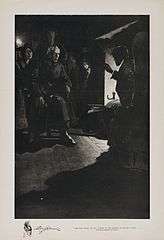 "The next night, by the corner of the hearth, in the best chair … Douglas began to read"
"The next night, by the corner of the hearth, in the best chair … Douglas began to read"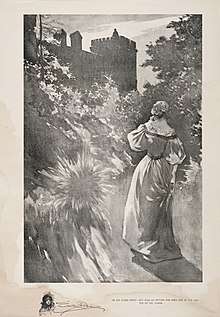 "He did stand there!—But high up, beyond the lawn and at the very top of the tower"
"He did stand there!—But high up, beyond the lawn and at the very top of the tower"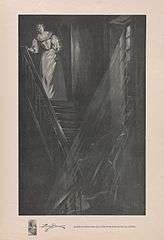 "Holding my candle high, till I came within sight of the tall window"
"Holding my candle high, till I came within sight of the tall window"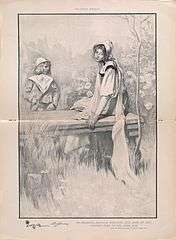 "He presently produced something that made me drop straight down on the stone slab"
"He presently produced something that made me drop straight down on the stone slab"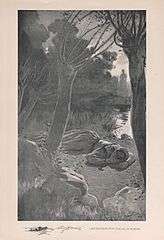 "I must have thrown myself, on my face, on the ground"
"I must have thrown myself, on my face, on the ground"
In October 1898 the novella appeared with the short story "Covering End" in a volume titled The Two Magics, published by Macmillan in New York City and by Heinemann in London.[11]
James revised The Turn of the Screw ten years later for his New York Edition.[12] In The Collier's Weekly Version of The Turn of the Screw (2010), the tale is presented in its original serial form with a detailed analysis of the changes James made over the years. Among many other revisions, James changed the children's ages.[13]
Adaptations
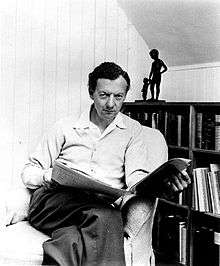
.jpg)
The Turn of the Screw has been the subject of a range of adaptations and reworkings in a variety of media, and these reworkings and adaptations have, themselves, been analysed in the academic literature on Henry James and neo-Victorian culture.[14] It was adapted to an opera by Benjamin Britten, which premiered in 1954,[14] and the opera has been filmed on multiple occasions.[15] The novella was adapted as a ballet score (1980) by Luigi Zaninelli,[16] and separately as a ballet (1999) by Will Tucket for the Royal Ballet.[17] Harold Pinter directed The Innocents (1950), a Broadway play which was an adaptation of The Turn of the Screw,[18] and a subsequent eponymous stage play, adapted by Rebecca Lenkiewicz was presented in a co-production with Hammer at the Almeida Theatre, London, in January 2013.[19]
Films
There have been numerous film adaptations of the novel.[16] The critically acclaimed The Innocents (1961), directed by Jack Clayton, and Michael Winner's prequel The Nightcomers (1972) are two particularly notable examples.[14] Other feature film adaptations include Rusty Lemorande's 1992 eponymous adaptation (set in the 1960s)[15]; Eloy de la Iglesia's Spanish-language Otra vuelta de tuerca (The Turn of the Screw, 1985);[16] Presence of Mind (1999), directed by Atoni Aloy; In a Dark Place (2006), directed by Donato Rotunno[15] and Walter Lima Jr.'s Brazilian-Portuguese-language Através da Sombra (Through the Shadow, 2016). The Others (2001) is not an adaptation but has some themes in common with James's novella.[15][20] In 2018, director Floria Sigismondi filmed an adaptation of the novella, called The Turning, on the Kilruddery Estate in Ireland.[21]
Television films have included a 1959 American adaptation as part of Ford Startime directed by John Frankenheimer and starring Ingrid Bergman;[15][22] the West German Die sündigen Engel (The Sinful Angel, 1962),[23] a 1974 adaptation directed by Dan Curtis, adapted by William F. Nolan;[15] a French adaptation entitled Le Tour d'écrou (The Turn of the Screw, 1974); a Mexican miniseries entitled Otra vuelta de tuerca (The Turn of the Screw, 1981);[23] a 1982 adaptation directed by Petr Weigl primarily starring Czech actors lip-synching;[24] a 1990 adaptation directed by Graeme Clifford; The Haunting of Helen Walker (1995), directed by Tom McLoughlin; a 1999 adaptation directed by Ben Bolt;[15] a low-budget 2003 version written and directed by Nick Millard;[23] the Italian-language Il mistero del lago (The Mystery of the Lake, 2009); and a 2009 BBC film adapted by Sandy Welch, starring Michelle Dockery and Sue Johnston.[23]
Literature
Literary references to and influences by The Turn of the Screw identified by the James scholar Adeline R. Tintner include The Secret Garden (1911), by Frances Hodgson Burnett; "Poor Girl" (1951), by Elizabeth Taylor; The Peacock Spring (1975), by Rumer Godden; Ghost Story (1975) by Peter Straub; "The Accursed Inhabitants of House Bly" (1994) by Joyce Carol Oates; and Miles and Flora (1997)—a sequel—by Hilary Bailey.[25] Further literary adaptations identified by other authors include Affinity (1999), by Sarah Waters; A Jealous Ghost (2005), by A. N. Wilson;[26] Florence & Giles (2010), by John Harding;[14] and The Turn of the Key (2019) by Ruth Ware.[27] Young adult novels inspired by The Turn of the Screw include The Turning (2012) by Francine Prose[28] and Tighter (2011) by Adele Griffin.[29]
Television
The Turn of the Screw has also influenced television.[30] In December 1968, the ABC daytime drama Dark Shadows featured a storyline based on The Turn of the Screw. In the story, the ghosts of Quentin Collins and Beth Chavez haunted the west wing of Collinwood, possessing the two children living in the mansion. The story led to a year-long story in the year 1897, as Barnabas Collins travelled back in time to prevent Quentin's death and stop the possession.[30] In early episodes of Star Trek: Voyager ("Cathexis", "Learning Curve" and "Persistence of Vision"), Captain Kathryn Janeway is seen on the holodeck acting out scenes from the holonovel Janeway Lambda one, which appears to be based on The Turn of the Screw.[31] On February 21, 2019, Netflix announced that the novella would be adapted as The Haunting of Bly Manor for the second season of its newly-announced anthology series that began with The Haunting of Hill House.[32][33]
Editions

20th century
- The Turn of the Screw: Authoritative Text, Contexts, Criticism, edited by Robert Kimbrough (New York: W.W. Norton & Company, 1966) [no ISBN].
- The Tales of Henry James, edited by Edward Wagenknecht (New York: Frederick Ungar Publishing Co. 1984) ISBN 0-8044-2957-X.
- The Aspern Papers and The Turn of the Screw, with an introduction and notes by Anthony Curtis (Harmondsworth: Penguin, 1986) ISBN 9780141439907. (Includes excerpts from the New York Preface to both novellas. Does not include a list of suggested further reading).
- The Turn of the Screw: Authoritative Text, Contexts, Criticism, edited by Deborah Esch and Jonathan Warren (New York: W.W. Norton & Company, 1999) ISBN 0-393-95904-X. (Offers a selection of criticism, including an excerpt from Edmund Wilson's study of the novella).
21st century
- The Turn of the Screw and Other Stories, edited by T.J. Lustig (Oxford: Oxford University Press, 2008) ISBN 978-0-199-53617-7.
- The Collier's Weekly Version of The Turn of the Screw, edited by Peter G. Beidler (Seattle: Coffeetown Press, 2010) ISBN 978-1-60381-018-0.
- The Turn of the Screw and Other Stories, edited by Kimberly Reed (Peterborough: Broadview Press, 2010) ISBN 978-1-770-48255-5.
- The Turn of the Screw, edited by David Bromwich (New York: Penguin Classics, 2011) ISBN 978-0-141-44135-1.
References
- Kaufmann, Professor Linda (1988). Discourses of Desire. ISBN 0-8014-9510-5. See this book for an argument that Bronte was actually the source of the tale, through Mary Sedgwick Benson.
- Elton, Oliver (1907). Modern studies /. London. hdl:2027/nyp.33433074965207.
- Slide 2013, p. 103.
- Smith, John (1957). "A Note on the Freudian Reading of 'The Turn of the Screw'". American Literature.
- Veeder, William (August 1999). "The Nurturance of the Gothic". Gothic Studies. 1: 47. doi:10.7227/GS.1.1.4.
- "Books: How we all came to love a good ghost story". The Daily Telegraph.
- The Gale Encyclopedia of the Unusual and Unexplained (PDF).
- Leithauser, Brad (October 2012). "Ever scarier on The Turn of the Screw". The New Yorker.
- Raine, Craig. "Sex in nineteenth-century literature". In Defence of T. S. Eliot.
- Orr 2009, p. 23.
- James, Henry (1996). Complete Stories, 1892–1898. New York: Library of America. p. 941. ISBN 978-1-883011-09-3.
- Orr 2009, p. 24.
- Henry James. Beidler, Peter G. (ed.). The Collier's Weekly Version of The Turn of the Screw. Coffeehouse Press.
- Dinter, Sandra (2012). "The mad child in the attic: John Harding's Florence & Giles as a neo-victorian reworking of The Turn of the Screw". Neo-Victorian Studies. 5 (1): 60–88.
- Haralson & Johnson 2009, p. 293.
- Brown, Monika (1998). "Film Music as Sister Art: Adaptations of 'The Turn of the Screw.'". Mosaic (Winnipeg). 31 (1).
- Jays, David (July 1, 2006). "Ballet – From page to stage". Financial Times. Retrieved January 5, 2015.
- Baker, William (2008). Harold Pinter. A&C Black. p. 32. ISBN 978-0-8264-9970-7.
- Masters, Tim (23 November 2012). "Hammer takes first steps on stage in Turn of the Screw". BBC News. Retrieved 13 February 2013.
- Skidelsky, William (30 May 2010). "Classics corner: The Turn of the Screw". The Guardian.
- Finn, Melanie (21 February 2018). "Steven Spielberg chooses Ireland as backdrop to new horror film". The Irish Independent.
- Koch, J. Sarah (2002). "A Henry James Filmography". In Griffin, Susan M. (ed.). Henry James Goes to the Movies. University Press of Kentucky. pp. 335–358. ISBN 978-0-8131-3324-9.
- Hischak 2012, p. 253.
- Holland, J. (2006). "Turn of the Screw (review)". Notes. 62 (3): 784–785. doi:10.1353/not.2006.0020.
- Tintner 1998, pp. 371–82.
- Heilmann 2010, pp. 111–30.
- https://inews.co.uk/culture/books/the-turn-of-the-key-by-ruth-ware-review-497737
- "The Turning by Francine Prose". Kirkus. 1 August 2012. Retrieved 10 September 2016.
- "Tighter by Adele Griffin". Kirkus. 15 April 2011. Retrieved 10 September 2016.
- Sborgi, Anna Viola (2011). "To think and watch the Evil: The Turn of the Screw as cultural reference in television from Dark Shadows to C.S.I.". Babel: Littératures Plurielles. 24: 181–94 (see paragraph 8).
- Ruditis, Paul (2003). Star Trek Voyager Companion. New York: Simon and Schuster. p. 25. ISBN 978-0-743-41751-8.
- Barsanti, Sam (21 February 2019). "The Haunting Of Hill House is taking on The Turn Of The Screw for its second season". The A.V. Club. Retrieved 16 May 2019.
- Whalen, Andrew (21 February 2019). "'The Haunting of Hill House' Season 2 Based on Sexually Ambiguous Book, Terrifying True Story". Newsweek. Retrieved 16 May 2019.
Works cited
- Haralson, Eric L.; Johnson, Kendall (2009). Critical Companion to Henry James: A Literary Reference to His Life and Work. Infobase Publishing. ISBN 978-1-4381-1727-0.CS1 maint: ref=harv (link)
- Heilmann, Ann (2010). "The Haunting of Henry James: Jealous Ghosts, Affinities and The Others". In Arias, Rosario; Pulham, Patricia (eds.). Haunting and Spectrality in Neo-Victorian Fiction: Possessing the Past. Palgrave Macmillan. ISBN 978-0-230-24674-4.CS1 maint: ref=harv (link)
- Hischak, Thomas S. (2012). American Literature on Stage and Screen: 525 Works and Their Adaptations. McFarland. ISBN 978-0-7864-9279-4.CS1 maint: ref=harv (link)
- Orr, Leonard (2009). James's The Turn of the Screw: A Readers Guide. London, New York: Bloomsbury. ISBN 978-0-8264-3019-9.CS1 maint: ref=harv (link)
- Simon, Linda (2007). The Critical Reception of Henry James: Creating a Master. London: Camden House. ISBN 978-1-571-13319-9.CS1 maint: ref=harv (link)
- Slide, Anthony (2013). Fifty Classic British Films, 1932-1982: A Pictorial Record. Courier Corporation. ISBN 978-0-486-14851-9.CS1 maint: ref=harv (link)
- Tintner, Adeline R. (1998). Henry James's Legacy: The Afterlife of His Figure and Fiction. Louisiana State University Press. ISBN 978-0-807-12157-3.CS1 maint: ref=harv (link)
Further reading
- Smith, Allan Lloyd. "A Word Kept Back in "The Turn of the Screw". In Clive Bloom (ed), Creepers: British Horror and Fantasy in the Twentieth Century. London and Boulder CO: Pluto Press, 1993, pp. 47–63.
External links
| Wikimedia Commons has media related to The Turn of the Screw. |
| Wikisource has original text related to this article: |
Primary sources
- The Turn of the Screw at Standard Ebooks
- The Turn of the Screw at Project Gutenberg (1898 book version)
- The Turn of the Screw via American Literature (full text)

- Author's preface to the New York Edition text of The Turn of the Screw (1908)
Secondary discussion
- Note on the various texts of The Turn of the Screw at the Library of America web site.
- Synopsis of The Turn of the Screw from the English Touring Opera
- turnofthescrew.com A History of Its Critical Interpretations 1898–1979 Edward J. Parkinson, PhD